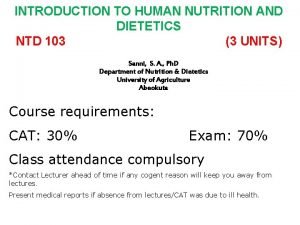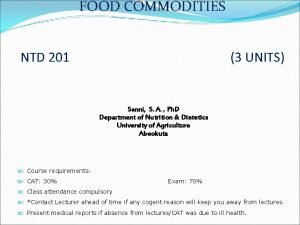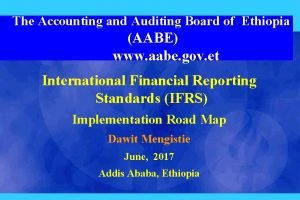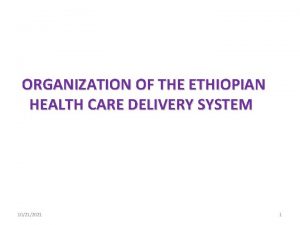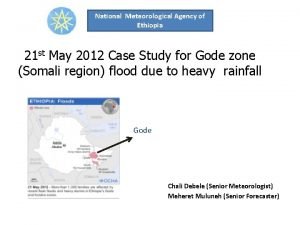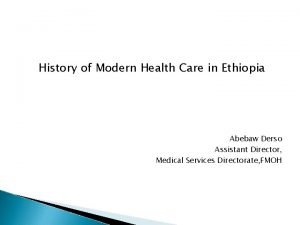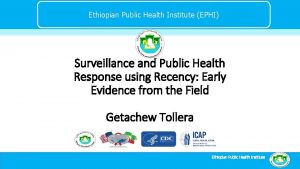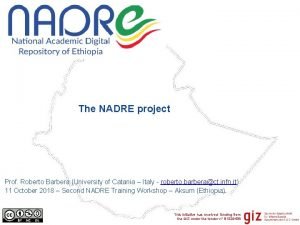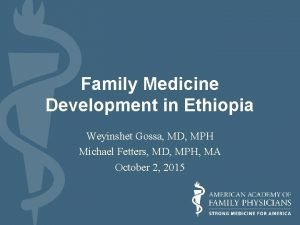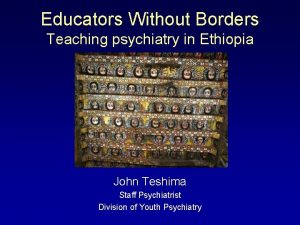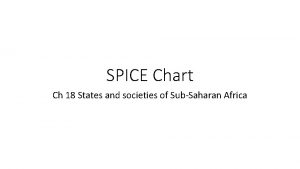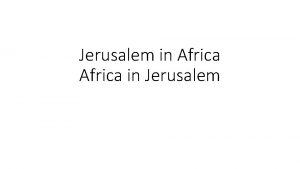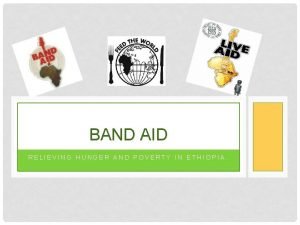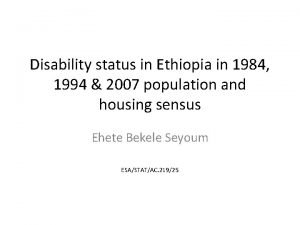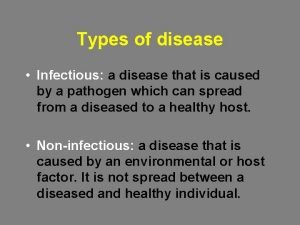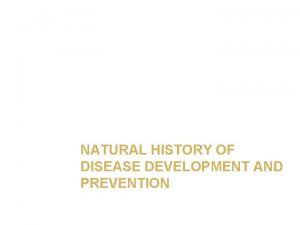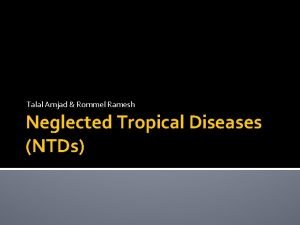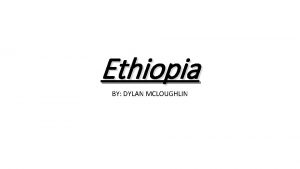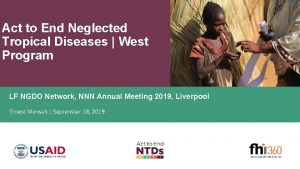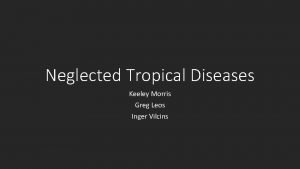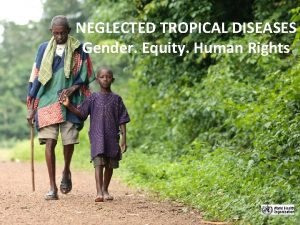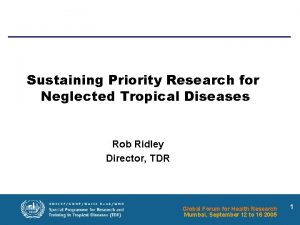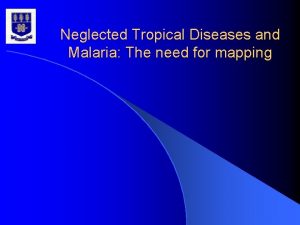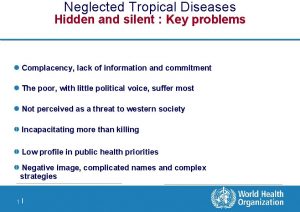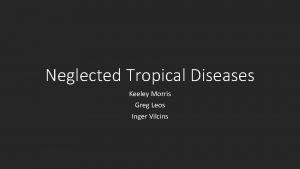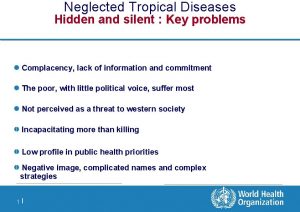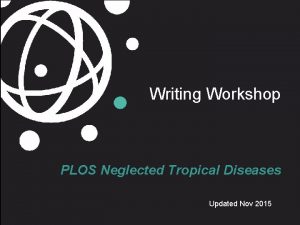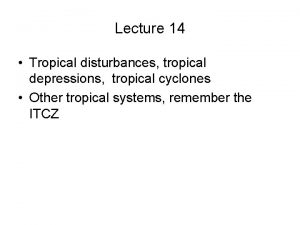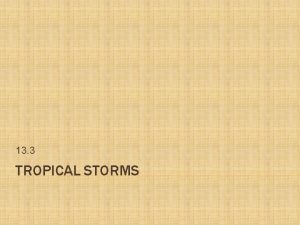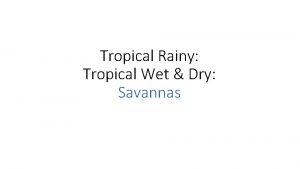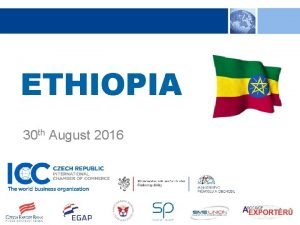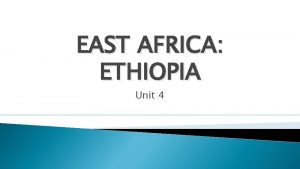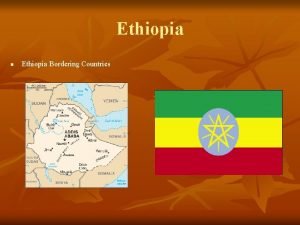Neglected Tropical Diseases NTDs Program in Ethiopia NTD
































- Slides: 32

Neglected Tropical Diseases (NTDs) Program in Ethiopia NTD Stakeholders Consultative Meeting 11 October 2019 Addis Ababa

Presentation outline NTD country overview Key achievements Opportunities Challenges Discussion points

Country basic facts • • • 110 million population 1. 1 million sq. km area 83% rural residents 9 regional states and 2 city administrations Diverse population with 80+ ethnic groups Federal government system • 1. 6 health professionals per 1, 000 population • Physician to population ratio – 1 : 11, 121 • 247+ hospitals; 3, 655 health centers; and 16, 527 health pots • Life Expectancy: Male 66. 34 and Female 67. 7 • Maternal Mortality: 412/100, 000 • Under five Mortality: 59/1000 • Infant Mortality: 41/1000

Global vs Ethiopia priority NTDs for intervention - 2016 -2020 • Mycetoma, chromboblastomycos and other deep mycoses • Buruli ulcer • Onchocerciasis(river blindness) • Chagas disease • Rabies • Dengue and chikungunya • Scabies and other ectoparasites • Dracunculiasis (Guinea-Worm disease) • Schistosomiasis • Echinococcosis • Soil-transmitted helminthiases • Foodborne trematodiasis • Snakebite envenoming • Human African trypanosomiasis (Sleeping sickness) • Taeniasis/cysticercosis • Leishmaniasis • Trachoma • Yaws (Endemic treponematoses) • Leprosy (Hansen’s disease) • Lymphatic filariasis • Podoconiosis Key strategies Ø Community engagement Ø Integrated approach Ø Preventive chemotherapy Ø Innovative and intensified disease management Ø Vector control Ø Wa. SH

The Road to NTDs Control and Elimination 2013/14 2015/16 • Key achievements: § Nationwide NTDs mapping; § Scale-up of MDA; § Launching of Fast Track TT Initiative; § Increased country ownership and leadership; § Stronger NTD Team Key achievements: § MDA integration; § Scale down MDA; § Post-treatment surveillance system; § Leveraging domestic financing; § NTD research forum. Beyond 2020 focus: o PC-NTD integration; o WASH-NTD coordination; o NTD program sustainability within the healthcare system; o Surveillance; o Hot spot/transmission zone identification and treatment; o Dossier development; o Elimination verification.

Neglected Tropical Diseases (NTDs) Program 2015 -2016 Goal • To reduce the burden of NTDs using innovative, high-quality and cost-effective approaches that lead to the achievement of the set national programme targets Objectives • Strengthening regional government ownership, advocacy, coordination and partnerships; • Scaling up access to NTD interventions and health system strengthening; • Enhancing planning for results, resource mobilization and financial sustainability of national NTDs programs; • Enhancing NTD monitoring and evaluation, surveillance and operational research.

NTD Program Key Progress

Schistosomiasis § 413 endemic woredas for SCH Goal: • High: 70 Eliminate SCH to a • Moderate: 153 level where it is no • Low: 190 longer a public health § 38. 1 M people at risk of problem by 2020. SCH infection Target: Reduce intensity of infection by 65 -90% from the baseline

Schistosomiasis and Soil Transmitted helminth § 741 endemic woredas for STH • High: 279 • Moderate: 215 • Low: 247 § 81 M people at risk of STH Goal: Control STH to a level where it is no longer a public health problem by 2020 Target: Reduce heavy and moderate infection intensity less than 1%

STH and SCH treatment coverage trend 2015/16 -2018/19 79 % 87% 83% 87% STH Trend 2015/16 to 2018/19 81% 77% 83% 85% SCH Trend 2015/16 to 2018/19 81%

SCH/STH Progress 2016 -2018

Trachoma • Ethiopia carries about 30% of the burden of trachoma in sub-Saharan Africa. • Global Trachoma Mapping Project (GTMP) results (2014): • 726 woredas endemic to trachoma; includes refugee camps in Beneshangul-Gumuz and Gambella. • 693, 037 people required surgery for trachomatous trichiasis (TT). Goal: Target: Eliminating trachoma by 2020. • TF <5% among 1 -9 years old children • TT < 0. 2 % among people aged 15 yrs and older or , 0. 1% among general population

Trend of trachoma treatment, 2003 -2018 G. G) 80 MDA scale-up - 2015 70 60 50 Millions 44 66 137 64 44 40 25 30 20 20 National Program Output 50 48 Annual Target (National Program) 2018 2017 2016 2015 26 2014 22 2013 19 2012 17 2011 5 12 18 2010 3 8 20 36 2009 2004 1 E-06 1 0 2003 - 1 15 2008 10 10 15 2007 1 2006 1 2005 20 20 59 o 100% geographical coverage o # of woredas stopped MDA

Trichiasis surgical output, 2001 -2018 450, 000 Fast Track • Insert historical surgical graph from Excel file. imitative launched 2015 350, 000 300, 000 250, 000 National Program Output 200, 000 Annual Target (National Program) 150, 000 100, 000 50, 000 Year 2018 2017 2016 2015 2014 2013 2012 2011 2010 2009 2008 2007 2006 2005 2004 2003 # Surgeries Conducted 400, 000

TF prevalence: Children 1 -9 years Baseline at 2013 Status at 2018

Progress achieved on Trachoma by region (2015 -18) Regions Count of District Sum of Back log Sum of Current to Stopped Managed till 2019 2015 manage MDA TT below 0. 2% Afar 28 3, 438 - 2, 069 Amhara 163 334, 631 340, 532 168, 734 46 1 BG 24 4, 871 - 3, 829 13 Gambella 20 5, 704 - 4, 869 4 Oromia 293 173, 834 141, 717 54, 524 49 22 SNNPR 135 121, 659 95, 715 52, 920 24 12 Somali 88 11, 560 - 7, 256 Tigray 40 37, 308 33, 026 16, 727 1 Grand Total 791 693, 087 610, 990 (88. 1%) 310, 912 137 35

Onchocerciasis elimination program in Ethiopia • 219 endemic woredas; • 20 million people at risk; • 160 woredas undergoing epidemiological mapping; • Oncho elimination Intervention with Ivermectin MDA. Goal: Target: Interrupt transmission of onchocerciasis. • Reduce and attain exposed children (<10 yrs. ) to 0. 1%; • Reduce and attain fly infection at 0. 05%.

Onchocerciasis treatment trend, 2001 - 2018 • Stop MDA declared in Metema sub-focus (in 8 woredas). • Nearly 1 million people became free from Onchocerciasis to-date. 11/5/2020

Lymphatic Filariasis • National epidemiological mapping was completed • In 2016 MDA was initiated in all 70 districts of the country. • After 5 rounds of MDA 18(25. 7%) districts are on stop MDA and targeted for disease elimination. • All primary, secondary and tertiary hospitals providing hydrocele surgery • 2, 832 hydrocele cases were operated

Podoconiosis • National epidemiological mapping were completed and 345 districts were identified as endemic for podoconiosis. • In 2018/19 MMDP service expansion for 301 districts of the country. • 67, 588 lymphedema cases were managed.

Trend of Guinea worm disease cases, 1993 - 2019 (n=4684) 11/5/2020 21

Human and animal GWD infections by month, 2017 -2019 YTD

Leishmaniasis Visceral leishmaniasis risk map Cutaneous leishmaniasis risk map Goal: Control Leishmani osis by 2020. • Maintain case fatality rate by VL at 3%; • Scale CL management. • 2. 9 million people at risk • Annual incidence: 2500 -4000 cases. 11/5/2020 • 30 million people at risk • Annual incidence: 20, 000 -50, 000 23

Treatment centre expansion and case management trend 11/5/2020 VL case fatality rate 24 1. 7%

Scabies • 379, 000 confirmed cases of scabies in 2015; • Mean prevalence: 35. 3% (0. 2 - 60. 7%) in 68 scabies affected woredas in Amhara region. [Wendemagegn Enbiale et al, 2018] • 704, 210+ cases reported from 180 woredas in 5 regions in 2017/18.

Scabies cases reported by region, 2016 -2017 700000 602482 600000 500000 400000 300000 200000 100000 70677 68408 585 339 17800 32929 13209 42 0 0 Amhara SNNPR Oromia 2016 Tigray BG 2017 • Annual years of health life lost due to scabies in Ethiopia is 36 per 100, 000 which is high when compared with other sub-Saharan African countries. 11/5/2020 26 • Children are most affected population group.

Water, sanitation, hygiene and NTDs • Established National WASH and NTD technical working group. • Established Regional WASHNTD technical working groups.

NTD Monitoring and Evaluation Includes 200+ NTD indicators Includes 9 NTD indicators and 25 data elements Data Import National NTD DHIS 2 data base Region Woreda & Zone Data collected in Routine DHIS 2 • All MDAs • Case management • Drug stock Health Center Health Post Disease Specific Survey WHO and other partners

Opportunities • HSTP - current and next cycle • National NTD Master Plan and technical guidelines • Strong primary health care system • Current health system reform including revision of the national health policy • School health policy and strategy • One WASH national program • Strong partnership 11/5/2020 29

Challenges • Resource intensive house-to-house visits to find TT cases ‘unknown to the health system’; • Inadequate WASH integration and coordination to complement and sustain gains from MDA; • Population movement across investment corridors and cross-borders; • Lack of scientific evidence on human – animal interface in Guinea worm transmission; • Insufficient scientific evidence for Cutanious leishmaniasis control program; • Absence of Global comprehensive guidelines to inform scabies control interventions; 11/5/2020 30

Amesegenalehu! Thank you!

Discussion points 1. Experiences and innovative approaches to enhancing cost-effectivess of NTD interventions. 2. How to expedite the 2020 goal for NTDs, e. g Trachoma, Onco 3. Scope of engagement for partners towards realizing effective WASH-NTD integration. 4. Addressing NTD issues in investment Corridors hard to reach areas and Universal health coverage. 5. District transformation plan on the context of NTDs 11/5/2020 32
 Ntd nutrition
Ntd nutrition Ntd 201
Ntd 201 Audit board of ethiopia
Audit board of ethiopia Six tier health system in ethiopia
Six tier health system in ethiopia National meteorological agency of ethiopia
National meteorological agency of ethiopia Modern medicine in ethiopia
Modern medicine in ethiopia Ephi ethiopia
Ephi ethiopia Iia ethiopia
Iia ethiopia Avv roberto barbera torino
Avv roberto barbera torino Health sector transformation plan ii ethiopia
Health sector transformation plan ii ethiopia Family medicine in ethiopia
Family medicine in ethiopia Psychiatry in ethiopia
Psychiatry in ethiopia Mali spice chart
Mali spice chart Ethiopia street jerusalem
Ethiopia street jerusalem Saips malawi
Saips malawi Ethiopia water
Ethiopia water Challenges of interest free banking in ethiopia
Challenges of interest free banking in ethiopia Ethiopia constitution
Ethiopia constitution Sher ethiopia plc
Sher ethiopia plc Invest in ethiopia
Invest in ethiopia Band aid ethiopia
Band aid ethiopia Mga pangyayari sa ikalawang digmaang pandaigdig timeline
Mga pangyayari sa ikalawang digmaang pandaigdig timeline Ethiopia religion
Ethiopia religion History of disability in ethiopia
History of disability in ethiopia How did ww1 contribute to ww2
How did ww1 contribute to ww2 Type of disease
Type of disease Quality definition by quality gurus
Quality definition by quality gurus Protein deficiency diseases
Protein deficiency diseases Diagram of natural history of disease
Diagram of natural history of disease Modern lifestyle and hypokinetic diseases
Modern lifestyle and hypokinetic diseases Major nutritional deficiency diseases in emergencies
Major nutritional deficiency diseases in emergencies Pflegmona
Pflegmona Prescriptive screening vs prospective
Prescriptive screening vs prospective
